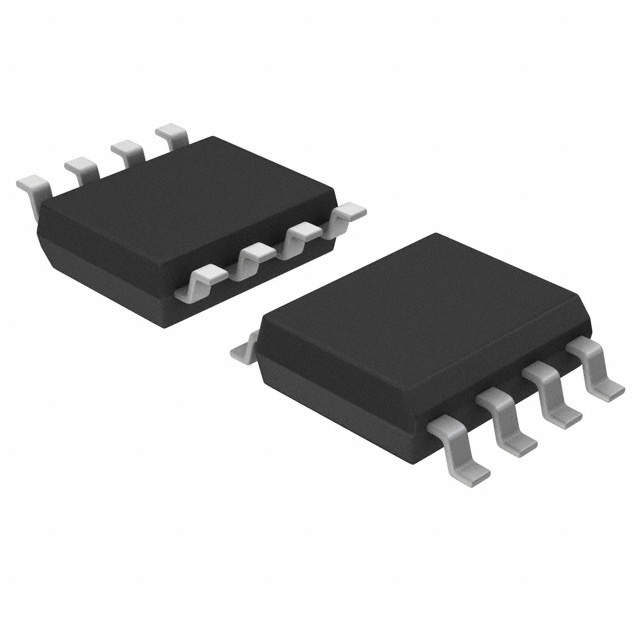Szczegóły produktu można znaleźć w specyfikacjach.

MX25L1026EM1I-10G
Basic Information Overview
- Category: Integrated Circuit (IC)
- Use: Non-volatile Memory
- Characteristics: High-speed, Low-power, Serial Flash Memory
- Package: SOP-8 (Small Outline Package)
- Essence: Stores and retrieves digital information in electronic devices
- Packaging/Quantity: Tape and Reel, 2500 pieces per reel
Specifications
- Memory Size: 1 Megabit (128 Kilobytes)
- Interface: Serial Peripheral Interface (SPI)
- Voltage Range: 2.7V to 3.6V
- Operating Temperature: -40°C to +85°C
- Data Retention: More than 20 years
- Erase/Program Cycle Endurance: 100,000 cycles
Detailed Pin Configuration
The MX25L1026EM1I-10G has a total of 8 pins arranged as follows:
┌───┬───┐
│ 1 │ 2 │
├───┼───┤
│ 3 │ 4 │
├───┼───┤
│ 5 │ 6 │
├───┼───┤
│ 7 │ 8 │
└───┴───┘
- Chip Select (/CS) - Enables communication with the device
- Serial Clock (SCLK) - Provides timing for data transfer
- Serial Data Input (SI) - Receives data from the external device
- Ground (GND) - Reference voltage for the circuit
- Serial Data Output (SO) - Transmits data to the external device
- Write Protect (/WP) - Protects the memory from accidental writes
- Hold (/HOLD) - Suspends the current operation
- Power Supply (VCC) - Provides power to the device
Functional Features
- High-speed data transfer with SPI interface
- Low-power consumption for energy-efficient operation
- Wide voltage range allows compatibility with various systems
- Reliable data retention for long-term storage
- Durable erase/program cycle endurance for frequent read/write operations
Advantages and Disadvantages
Advantages: - Fast data transfer rate - Low power consumption - Compact package size - Wide operating temperature range - Long data retention period
Disadvantages: - Limited memory size compared to other storage devices - Relatively low erase/program cycle endurance
Working Principles
The MX25L1026EM1I-10G utilizes the Serial Peripheral Interface (SPI) to communicate with the host device. It stores digital information in non-volatile memory cells, which retain data even when power is removed. The device can be accessed by sending commands through the SPI interface, allowing for reading, writing, erasing, and programming of data.
Detailed Application Field Plans
The MX25L1026EM1I-10G is commonly used in various electronic devices that require non-volatile memory storage. Some application fields include: - Consumer electronics (e.g., smartphones, tablets, digital cameras) - Automotive systems (e.g., infotainment, instrument clusters) - Industrial equipment (e.g., control systems, data loggers) - Communication devices (e.g., routers, modems)
Detailed and Complete Alternative Models
- MX25L512E: 512 Kilobit (64 Kilobytes) Serial Flash Memory
- MX25L256E: 256 Kilobit (32 Kilobytes) Serial Flash Memory
- MX25L128E: 128 Kilobit (16 Kilobytes) Serial Flash Memory
- MX25L64E: 64 Kilobit (8 Kilobytes) Serial Flash Memory
These alternative models offer different memory sizes to suit specific application requirements.
Word count: 343 words
Wymień 10 typowych pytań i odpowiedzi związanych z zastosowaniem MX25L1026EM1I-10G w rozwiązaniach technicznych
Sure! Here are 10 common questions and answers related to the application of MX25L1026EM1I-10G in technical solutions:
Q1: What is MX25L1026EM1I-10G? A1: MX25L1026EM1I-10G is a specific model of flash memory chip manufactured by Macronix. It has a capacity of 1 megabit (128 kilobytes) and operates at a speed of 10 MHz.
Q2: What are the typical applications of MX25L1026EM1I-10G? A2: MX25L1026EM1I-10G is commonly used in various electronic devices such as routers, set-top boxes, digital cameras, and other consumer electronics that require non-volatile storage for firmware or data storage purposes.
Q3: What is the interface used by MX25L1026EM1I-10G? A3: MX25L1026EM1I-10G uses a Serial Peripheral Interface (SPI) for communication with the host microcontroller or system.
Q4: What voltage levels does MX25L1026EM1I-10G support? A4: MX25L1026EM1I-10G supports a wide range of voltage levels, typically from 2.7V to 3.6V.
Q5: Can MX25L1026EM1I-10G be easily soldered onto a PCB? A5: Yes, MX25L1026EM1I-10G comes in a standard 8-pin SOIC package, which can be easily soldered onto a PCB using conventional surface mount technology.
Q6: Does MX25L1026EM1I-10G have any security features? A6: Yes, MX25L1026EM1I-10G supports hardware-based write protection and software-based protection mechanisms to prevent unauthorized access or modification of stored data.
Q7: What is the endurance of MX25L1026EM1I-10G? A7: MX25L1026EM1I-10G has a typical endurance of 100,000 program/erase cycles, which means it can be written and erased up to 100,000 times before it may start to degrade.
Q8: Can MX25L1026EM1I-10G operate in extreme temperature conditions? A8: Yes, MX25L1026EM1I-10G is designed to operate reliably in a wide temperature range, typically from -40°C to +85°C.
Q9: Is MX25L1026EM1I-10G compatible with other flash memory chips? A9: MX25L1026EM1I-10G follows industry-standard protocols and pinouts, making it compatible with other SPI flash memory chips from various manufacturers.
Q10: Are there any specific programming requirements for MX25L1026EM1I-10G? A10: MX25L1026EM1I-10G requires specific commands and timing sequences for programming and erasing operations. The datasheet provided by Macronix contains detailed information on the programming requirements.
Please note that the answers provided here are general and may vary depending on the specific application and requirements. It is always recommended to refer to the official datasheet and consult with technical experts for accurate and detailed information.

